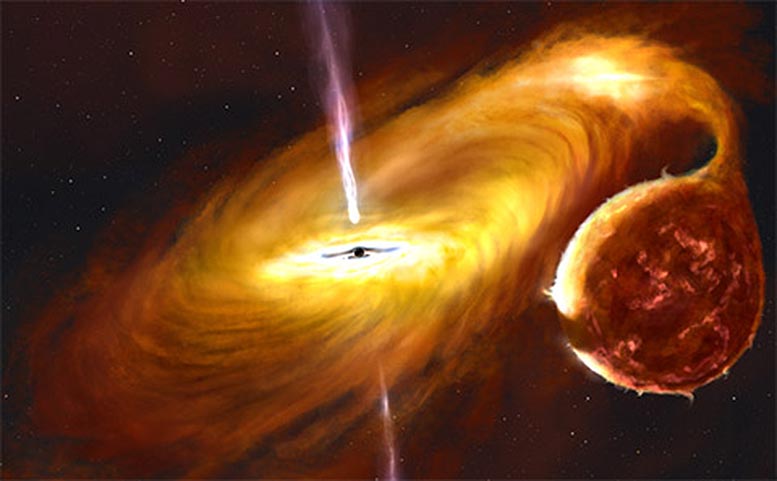An international team of astrophysicists from South Africa, the UK, France and the US have found large variations in the brightness of light seen from around one of the closest black holes in our Galaxy, 9,600 light-years from Earth, which they conclude is caused by a huge warp in its accretion disc.
This object, MAXI J1820+070, erupted as a new X-ray transient in March 2018 and was discovered by a Japanese X-ray telescope onboard the International Space Station. These transients, systems that exhibit violent outbursts, are binary stars, consisting of a low-mass star, similar to our Sun and a much more compact object, which can be a white dwarf, neutron star, or black hole. In this case, MAXI J1820+070 contains a black hole that is at least 8 times the mass of our Sun.
The first findings have now been published in the international highly ranked journal, Monthly Notices of the Royal Astronomical Society, whose lead author is Dr. Jessymol Thomas, a Postdoctoral Research Fellow at the South African Astronomical Observatory (SAAO).
The discovery presented in the paper was made from an extensive and detailed light-curve obtained over almost a year by dedicated amateurs around the globe who are part of the AAVSO (American Association of Variable Star Observers). MAXI J1820+070 is one of the three brightest X-ray transients ever observed, a consequence of both its proximity to Earth and being outside of the obscuring plane of our Milky Way Galaxy. Because it remained bright for many months, this made it possible to be followed by so many amateurs.
Professor Phil Charles, researcher at the University of Southampton and member of the research team explained, “material from the normal star is pulled by the compact object into its surrounding accretion disc of spiraling gas. Massive outbursts occur when the material in the disc becomes hot and unstable, accretes onto the black hole and releases copious amounts of energy before traversing the event horizon. This process is chaotic and highly variable, varying on timescales from milliseconds to months.”
The research team have produced a visualization of the system, showing how a huge X-ray output emanates from very close to the black hole, and then irradiates the surrounding matter, especially the accretion disc, heating it up to a temperature of around 10,000K, which is seen as the visual light emitted. That is why, as the X-ray outburst declines, so does the optical light.
But something unexpected happened almost 3 months after the outburst began when the optical light curve started a huge modulation – a bit like turning a dimmer switch up and down and almost doubling in brightness at its peak — on a period of about 17 hours. Yet there was no change whatsoever in the X-ray output, which remained steady. While small, quasi-periodic visible modulations had been seen in the past during other X-ray transient outbursts, nothing on this scale had ever been seen before.
What was causing this extraordinary behavior? “With the angle of view of the system as shown in the pictorial, we could quite quickly rule out the usual explanation that the X-rays were illuminating the inner face of the donor star because the brightening was occurring at the wrong time”, said Prof. Charles. Nor could it be due to varying light from where the mass transfer stream hits the disc as the modulation gradually moved relative to the orbit.
This left only one possible explanation, the huge X-ray flux was irradiating the disc and causing it to warp, as shown in the picture. The warp provides a huge increase in the area of the disc that could be illuminated, thereby making the visual light output increase dramatically when viewed at the right time. Such behavior had been seen in X-ray binaries with more massive donors, but never in a black-hole transient with a low mass donor like this. It opens a completely new avenue for studying the structure and properties of warped accretion discs.
Prof Charles continued, “This object has remarkable properties amongst an already interesting group of objects that have much to teach us about the end-points of stellar evolution and the formation of compact objects. We already know of a couple of dozen black hole binary systems in our Galaxy, which all have masses in the 5 – 15 solar mass range. They all grow by the accretion of matter that we have witnessed so spectacularly here.”
Starting some 5 years ago, a major science program on the Southern African Large Telescope (SALT) to study transient objects has made a number of important observations of compact binaries, including black hole systems like MAXI J1820+070. As the Principal Investigator for this program, Prof. Buckley, states “SALT is a perfect tool to study the changing behavior of these X-ray binaries during their outbursts, which it can monitor regularly over periods of weeks to months and can be coordinated with observations from other telescopes, including space-based ones.”
Reference: “Large optical modulations during 2018 outburst of MAXI J1820+070 reveal evolution of warped accretion disc through X-ray state change” by Jessymol K Thomas, Philip A Charles, David A H Buckley, Marissa M Kotze, Jean-Pierre Lasota, Stephen B Potter, James F Steiner andJohn A Paice, 26 October 2021, Monthly Notices of the Royal Astronomical Society.
DOI: 10.1093/mnras/stab3033










I assume we’ll be ‘photographing’ it, then? After all, it’s 1000 times closer to us than the last Black SChmole we faked a photo of!
How do you take ‘fake’ photos?
No, the observations aren’t photographs, they are images based on data. Since it gave a Nobel Prize, you can easily search how it was done.
Fìrst a balanced state of equilibrium of impact forces of infalling X-rays and òutgoing visible light is established for a time length,while the X-ray delivering black hole can double its activity is an extra,so wrong time period of 17 hours.Thanks to the Authors.
Fìrst a balanced state of equilibrium of impact forces of infalling X-rays and òutgoing visible light is established for a time length,while the X-ray delivering black hole can double its activity is an extra,so wrong time period of 17 hours.Thanks to the Authors.
This is due to dark energy from the origin or big bang.
Evangellion’s Angel?
🙂🙂🙂🙂
There is only way not to see the factual truth and everyone knows the truth at one or another. She is on the earth and what is happing to her in more ways than one. Now its not just what is happening to her physically but the stealing of her clothing and her shoes. Breaking into her homes and that in which saved us through history being to say the ones stealing her music ect. No matter how many hi how are you doing by so many others world wide or how many people are leading that some of the best books ever written have been over looked by their cover or how many people stop and open the door for someone now on their way in or out that same door.or how about the trash bin instid of our streets are over flowing.
Those not near her keep up the good work someday it will work out her way, but those of you near by join together and pull her from the clenches of her assailants.
?
Also, what relevance?